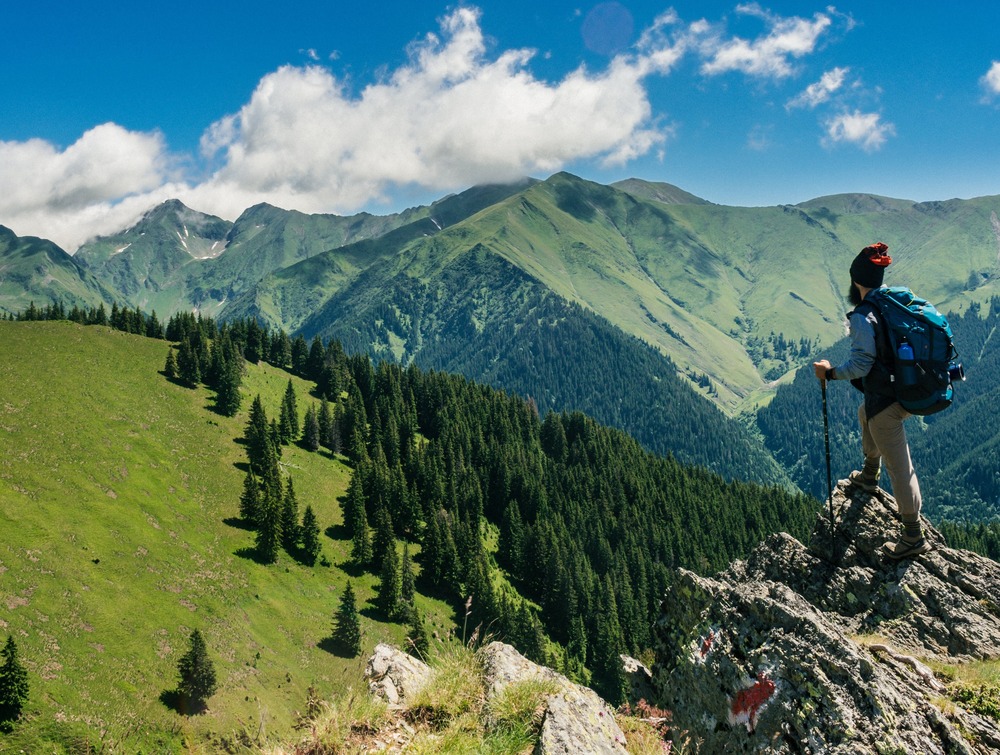Your safety on a mountain bike ride depends heavily on the quality of the helmet you’re wearing. To make sure you have the right gear to protect you in case of accidents, we have put together this detailed guide.
We’ll give you a deep dive into mountain bike helmets, from the anatomy of a helmet to choosing the right one for you. So, sit back grab a drink and continue reading, mountain bike helmets, invest in your safety. Let`s get started.
Understanding Mountain Bike Helmets
What Constitutes a Mountain Bike Helmet?
A mountain bike helmet is not just a simple piece of equipment, but a blend of technology and design. Its main parts are the outer shell, inner liner, retention system, and straps.
The outer shell, typically made of polycarbonate, absorbs impact. The inner liner, usually made of EPS foam, protects the head from shocks. The retention system and straps keep the helmet secure on the rider’s head.

How Do Mountain Bike Helmets Differ from Other Helmets?
Mountain bike helmets, often referred to as MTB helmets, differ from other helmets in several ways. They have a distinct shape with extended coverage for the back of the head.
They come equipped with a visor, and ventilation is an important consideration in their design. Furthermore, some mountain bike helmets include additional features like full-face protection and integrated camera mounts.
A Deep Dive into Helmet Safety Standards
Helmet safety standards ensure that all helmets provide a certain minimum level of protection.
In the US, all bike helmets must meet the Consumer Product Safety Commission (CPSC) standards, which test for impact absorption, strap strength, and coverage. Other countries have their own standards which should be met.
Mountain Bike Helmet Types
There are three main types of mountain bike helmets: cross-country (XC), trail, and downhill (DH) or full-face helmets. XC helmets are lightweight and ventilated, making them perfect for long-distance riders.
Trail helmets provide more protection and feature a built-in visor. DH helmets are full-face helmets designed to protect against high-speed crashes.

There are several factors to consider when choosing a mountain bike helmet.
Choosing the Right Mountain Bike Helmet: Factors to Consider When Buying a Helmet.
Size and Fit
Mountain bike helmets come in a variety of sizes and fit to ensure maximum comfort and safety for riders of all shapes and sizes. The size and fit of a mountain bike helmet are crucial factors that contribute to its effectiveness in protecting your head during rides on rugged terrains.
When selecting a mountain bike helmet, it’s essential to consider its size range and fit adjustment mechanisms. Most helmets are designed to accommodate a specific range of head circumferences, which is usually indicated in centimetres or inches.
Measure
To find the right size, measure your head’s circumference just above your eyebrows and ears. A properly fitting mountain bike helmet should sit snugly on your head, without being too tight or too loose. It should cover your forehead and the back of your head, ensuring that vital areas are protected in case of an impact.
The helmet’s retention system, often consisting of straps and a dial-adjustable fit system at the rear, allows you to fine-tune the fit to match your head’s shape and size. This ensures a secure and comfortable fit that minimizes movement during your ride.
A well-fitted helmet should stay in place even when you move your head vigorously from side to side or up and down. The front edge of the helmet’s brim should be about one to two finger-widths above your eyebrows, providing an unobstructed field of vision while still offering forehead protection.
The chin straps should be adjusted to form a V-shape around your ears and fastened securely beneath your chin. Remember that a helmet’s fit can be influenced by hair length, hairstyle, and personal preferences, so it’s advisable to try on different sizes and models before making a final decision.
Additionally, some brands might offer different shell shapes and internal padding designs to cater to various head shapes. Choosing the right size and fit for your mountain bike helmet is essential for your safety and comfort during your off-road adventures.
A properly fitted helmet will provide the best protection and allow you to focus on enjoying the thrill of mountain biking while staying safe on the trails.

Weight
A mountain bike helmet typically weighs around 250 to 350 grams (8.8 to 12.3 ounces). These helmets are designed to be lightweight yet sturdy, providing essential protection to the rider’s head during off-road biking adventures.
The helmets are crafted using advanced materials like polycarbonate shells, and expanded polystyrene (EPS) foam liners, and are occasionally reinforced with additional technologies for impact absorption and rotational force reduction.
The combination of lightweight construction and innovative safety features ensures that riders can enjoy their mountain biking experience with reduced strain on their necks while maintaining a high level of head protection.
It’s important to note that exact weights may vary based on helmet size, design, and the specific technologies incorporated by different manufacturers.
Ventilation
Ventilation in mountain bike helmets plays a critical role in ensuring rider comfort and safety during intense off-road rides. These helmets are designed with multiple strategically placed vents that facilitate the flow of air through the helmet, helping to regulate temperature and reduce heat build-up.
The ventilation system in mountain bike helmets is carefully engineered to balance between maintaining aerodynamics and providing effective cooling. The vents are strategically positioned to create channels for air to enter from the front and sides and exit from the rear.
This design allows for a constant exchange of fresh air, which helps dissipate heat generated from the rider’s head while pedalling and tackling challenging trails. The number, size, and shape of vents can vary among different helmet models, but the overall goal remains consistent: to provide adequate airflow without compromising the helmet’s structural integrity.
Internal channels and exhaust ports work together to channel air over the rider’s scalp, providing relief from both heat and sweat accumulation. Mountain biking often involves physically demanding climbs and descents, where body temperature can rise rapidly.
Proper ventilation helps prevent overheating, dizziness, and discomfort, allowing the rider to maintain focus and perform at their best. Additionally, improved airflow minimizes the potential for fogging in eye wear, enhancing visibility on the trail.
When selecting a mountain bike helmet, riders often consider the ventilation system as a crucial factor. Helmets with superior ventilation tend to have a higher number of vents and advanced airflow management, providing a more comfortable experience during extended rides in varying weather conditions.
Ventilation in mountain bike helmets is a well-thought-out design feature that enhances rider comfort by promoting airflow and heat dissipation. It’s an essential component for ensuring a safe and enjoyable biking experience on challenging trails.
Protection
A mountain bike helmet is an essential piece of protective gear designed to safeguard your head during cycling activities, particularly in off-road and rugged terrains. Its primary purpose is to minimize the risk of head injuries in case of falls, collisions, or accidents while riding on challenging trails.

The protection provided by a mountain bike helmet can be described as follows:
Impact Absorption
Mountain bike helmets are constructed with layers of specialized materials, such as expanded polystyrene (EPS) foam, which is designed to absorb and disperse the force of an impact. This cushioning effect helps reduce the impact energy transferred to the head, lessening the likelihood and severity of head injuries.
Shell Strength
The outer shell of a mountain bike helmet is usually made from tough and durable materials like polycarbonate or composite plastics. This shell adds an extra layer of protection by distributing and absorbing some of the force before it reaches the inner foam.
Coverage
Mountain bike helmets typically offer extended coverage compared to regular bike helmets. They provide protection not only for the top of the head but also for the sides and back. This extended coverage helps safeguard against impacts from various angles.
Retention System
A secure and properly fitted helmet is crucial for its protective capabilities. Most mountain bike helmets come with an adjustable retention system, often a dial or strap, to ensure a snug and comfortable fit. A well-fitting helmet stays in place during sudden movements and impacts.
Visor
Many mountain bike helmets include a visor that extends outward from the front. The visor provides shade from the sun, shields the eyes from debris, and offers an additional layer of protection for the forehead area.

Certification Standard
Reputable mountain bike helmets adhere to industry safety standards, such as those set by organizations like the Consumer Product Safety Commission (CPSC) in the United States and similar bodies in other countries. Helmets meeting these standards have undergone rigorous testing to ensure their protective qualities.
Replace After Impacts
It’s important to note that after a significant impact, even if the helmet appears undamaged, its protective capabilities could be compromised. It’s advisable to replace a helmet after any significant crash or impact to maintain its effectiveness. A mountain bike helmet is a vital accessory for any off-road cyclist.
Its design combines impact absorption, shell strength, extended coverage, a proper retention system, ventilation, and adherence to safety standards to provide comprehensive protection during mountain biking adventures. Always remember to wear a well-fitting and certified helmet to maximize your safety while enjoying your rides.
The Cost
A mountain bike helmet is an essential piece of protective gear designed to provide safety and reduce the risk of head injuries while riding off-road trails or rugged terrains. The cost of a mountain bike helmet can vary significantly based on several factors, including brand reputation, features, materials used, design, and additional technologies.
At the lower end of the price spectrum, you can find basic mountain bike helmets that offer fundamental protection without many advanced features. These helmets often have a simple construction, basic ventilation, and minimalistic designs. They can typically range from $20 to $50.
In the mid-range, you’ll discover helmets with improved ventilation, better comfort features, enhanced aesthetics, and sometimes added safety technologies. Helmets in this category may fall within the $50 to $150 range and strike a good balance between affordability and performance.
At the higher end of the cost spectrum, premium mountain bike helmets come into play. These helmets often boast advanced safety features such as MIPS (Multi-directional Impact Protection System) or SPIN (Shearing Pad Inside), which are designed to reduce rotational forces on the head during impacts.
They also tend to have superior ventilation, lightweight materials, customizable fit systems, and sleek designs. Premium helmets can range from $150 to $400 or more, depending on the brand and features.
It’s important to note that while cost can be an indicator of quality and additional features, all helmets sold in reputable stores should meet established safety standards. When choosing a mountain bike helmet, prioritize finding one that fits well, is comfortable, and provides adequate protection for your riding style and preferences.
Remember that investing in a high-quality helmet is an investment in your safety while enjoying the thrills of mountain biking.

Trying Out Helmets Before Purchase
Trying out mountain bike helmets before making a purchase is a great idea to ensure the helmet fits well and provides proper protection. Here’s a guide on what to consider and how to go about it:
Research Online
Start by researching different mountain bike helmet brands and models online. Read reviews, check specifications, and identify helmets that are known for their safety features, comfort, and durability.
This will give you a good idea of what’s available in the market.
Visit a Local Bike Shop
Find a local bike shop that carries a variety of mountain bike helmets. Bike shops often have knowledgeable staff who can help you choose the right helmet based on your head size, riding style, and preferences.
Check Sizing
Helmet sizing can vary between brands, so it’s important to try on different sizes to find the one that fits you best. The helmet should sit snugly on your head without being too tight or causing discomfort.
It should also cover your forehead and sit level on your head.
Adjustability
Look for helmets with adjustable straps and retention systems. These features allow you to fine-tune the fit of the helmet for maximum comfort and security.
Try Different Models
Don’t hesitate to try on different helmet models from various brands. Each brand might have a slightly different fit and shape, so experimenting with different options will help you find the one that suits you best.
Wear it Properly
When trying on helmets, make sure to adjust the chin straps and retention system according to the manufacturer’s instructions. The helmet should sit level on your head and not tilt forward or backwards.
Mimic Riding Positions
While trying on helmets, mimic the riding positions you’ll be in while on the trails. This will help you ensure that the helmet stays securely in place even during active movements.
Consider Ventilation
Mountain biking can be physically demanding, so consider helmets with adequate ventilation to keep you cool during rides. Ventilation is important, especially in warm weather.
Ask for Advice
Don’t hesitate to ask the bike shop staff for their recommendations. They can provide valuable insights based on their experience and knowledge of different helmet brands.
Assess Comfort and Weight
Pay attention to how comfortable the helmet feels on your head. Additionally, consider the weight of the helmet, as a lighter helmet can reduce strain during longer rides.
Safety Standards
Ensure that the helmets you’re trying out meet safety standards like CPSC (Consumer Product Safety Commission) certification. This ensures that the helmet provides the necessary impact protection.
Test Accessories Compatibility
If you use accessories like goggles or a camera mount, bring them along and see how they fit with the helmet you’re trying on.

Take Your Time
Choosing the right helmet is important, so take your time during the fitting process. A well-fitting helmet can make a significant difference in your comfort and safety while riding.
Remember that a proper-fitting helmet is an investment in your safety and riding experience. Take the opportunity to try on different options and make an informed decision based on fit, comfort, safety features, and personal preferences.
Maintaining Your Mountain Bike Helmet
Cleaning Your Helmet
Regular cleaning is essential to maintain the longevity of your helmet. Use mild soap and warm water, avoiding harsh detergents that can degrade the materials. Always air dry the helmet after washing.
When to Replace Your Helmet
As a general rule, you should replace your helmet every 3-5 years, or immediately after a crash. Even if there are no visible signs of damage, the helmet’s ability to protect may be compromised.
FAQ’s (Frequently Asked Questions)
Is it possible to utilize a road bike helmet for mountain biking?
You can, but it’s not recommended. Mountain bike helmets are designed with specific features like more head coverage, a visor for sun and debris protection, and sometimes a full face for downhill riding.
While it’s technically possible to use a road bike helmet for mountain biking, it’s not the ideal choice and might not provide the same level of protection and comfort as a helmet specifically designed for mountain biking.
What is MIPS in a helmet?
MIPS is an acronym representing the Multi-directional Impact Protection System. It is a technology that allows the helmet to slide relative to the head in the event of a crash, reducing rotational forces that can cause brain injuries.
How can I determine if my helmet is properly fitting?
A correctly fitting helmet ought to be comfortably secure without being overly tight. It should sit level on your head and not tilt back. The front edge should be about an inch above your eyebrows.
The straps should form a “V” under each ear, and when you open your mouth wide, you should feel the helmet press against your head.
How often should I replace my mountain bike helmet?
You should replace your helmet every 3-5 years, or immediately after a crash, even if there are no visible signs of damage.
Are more expensive helmets safer?
Not necessarily. All helmets sold in the US must meet the same CPSC standards, which means they offer the same base level of protection. However, more expensive helmets often have additional safety features, better ventilation, lighter weight, and improved comfort.
Can I customize my mountain bike helmet?
Yes, many riders customize their helmets with stickers, paint, or other adornments. However, avoid drilling holes or making modifications that could affect the helmet’s integrity and safety.
Conclusion
Choosing a mountain bike helmet is a critical decision that directly impacts your safety while riding. Understanding the various types of helmets, their safety features, and how to properly maintain them can help you make the best choice. Always remember to prioritize fit and comfort, and never compromise on safety.



